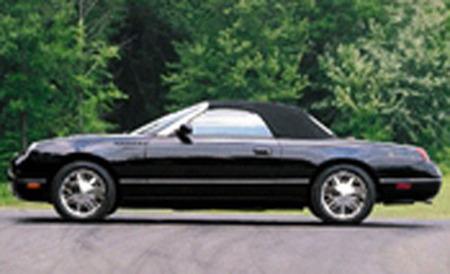“He took the noise out of the design,” says his colleague, designer Mark Conforzi. The team led by Mays, chief designer Doug Gaffka, and Conforzi changed surfaces, bumpers, grille textures, hood scoops, front fender “vents,” wheel openings, and the taillamps, which were inspired not by any of the roadsters but by the later 1961 model.
The planned high-tech interior, based on the Lincoln LS instrumentation, was scrapped. Conforzi says, “It just didn’t have the romance of the originals we had in the studio with us. We kept looking at them, and we ended up with the fluted doors and the wing shapes on the door panels. We kept the two-tone dash, the original seat style, and real metal appliques on the dash.” Original touches include a turquoise-accented hood ornament and turquoise accents on the black-on-white instruments. Colors will be very similar to the 1955 palette.
The Thunderbird’s chassis is on a tidy 107.2-inch wheelbase, 7.3 inches shorter than the Jag S-type’s, with an overall length of 186.3 inches, five inches shorter than the imported sedan. The car is only 52.1 inches tall and 72.0 inches wide, with a front-track measurement of 60.5 inches and a rear track of 60.2 inches, a few ticks narrower than the Jaguar’s. With two fewer doors than the 3900-pound Jag sedan and a cloth top, the Thunderbird should tip the scales at about 3600 pounds.
With its isolated subframes, fully independent front and rear suspensions, and all-disc ABS, the chassis has already proved itself worthy under the Lincoln LS and the Jaguar S-type. The T-Bird team has dialed in its variable-ratio power rack-and-pinion steering, a completely new set of geometry settings and bushings, and 115 percent anti-dive in this low-riding iteration.
Ford officials promise a new level of steering, handling, and braking precision for the T-Bird, noting that Ford product development V-P Richard Parry-Jones and his lads have been working hard on it in the final phases of chassis tuning and getting the weight balance close to 50/50. It will use 17-inch cast aluminum spoked wheels and tall, meaty P235/50VR-17 tires, not low-profile 18s or 19s, and not Z-rated. This ain’t no muscle car.
We have seen the powertrain before. It’s essentially the same 3.9-liter aluminum alloy V-8 engine found in the Lincoln LS (252 horsepower at 6100 rpm and 267 pound-feet of torque at 4300 rpm), with a substantially more sporty exhaust system and a handful of internal improvements that will give future Thunderbird customers more horsepower and torque. What should result is substantially better performance than the Lincoln’s because the Thunderbird is likely to be hundreds of pounds lighter, owing to its sheet-molding-compound plastic fascias, hood, fenders, decklid, and removable top. That should put 0-to-60 times in the seven-second-flat area — a long way from Corvette territory, but then the new T-Bird doesn’t pretend to be a sports car.
It comes only with the same five-speed automatic transmission used in the Lincoln LS. There will be no manual transmission such as the one offered in the LS V-6, at least not in the first year of production.
Standard equipment is prodigious: four airbags, power leather seats with six-way tuning on the driver’s side, a 15-inch leather-wrapped, four-spoke steering wheel with redundant controls for sound system and cruise, an AM/FM radio with a six-disc CD changer, speed-sensitive wipers, and Ford’s SecuriLock and passive anti-theft systems. The options list is a short one: chrome wheels in lieu of painted wheels, the removable top with its carrying cart and cover, an interior upgrade package, and all-speed traction control.
In Ford’s eyes, the Thunderbird will compete in style and price with the entire squadron of $40,000-plus German roadsters, including the Audi TT Quattro, the BMW Z3, the Porsche Boxster, and the newly souped-up Mercedes SLK V-6. And it does so with the only V-8 engine in the group, and it definitely, absolutely does not compete with the Corvette. Ford expects the heart of the market to be a 50/50 mix of male and female buyers about 45 years of age, with the rest ranging from well-to-do dot.commers of 25 to wealthy empty nesters 65 and over.
Will it be around for the long run? J Mays thinks so. “The enthusiasm for this car will be there for the entire run. This is not a flash-in-the-pan toy. It’s not a caricature of what a classic should be. It’s a classic automobile.”


Leave a Reply